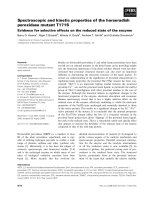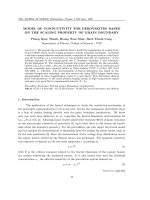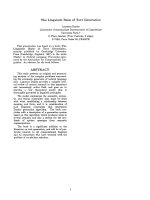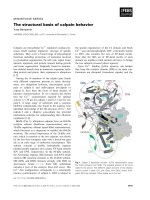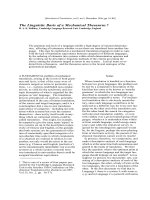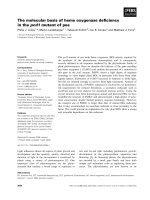Accounting for heritage assets under the accrual basis of accounting
Bạn đang xem bản rút gọn của tài liệu. Xem và tải ngay bản đầy đủ của tài liệu tại đây (1.57 MB, 72 trang )
International
Public Sector
Accounting
Consultation Paper
February 2006
Comments are requested by June 30, 2006
Standards Board
Accounting for Heritage Assets
Under the Accrual Basis of
Accounting
REQUEST FOR COMMENTS
The International Public Sector Accounting Standards Board (IPSASB) is an independent
standard-setting body within the International Federation of Accountants (IFAC). It approved this
Consultation Paper, Accounting for Heritage Assets under the Accrual Basis of Accounting, for
publication in February 2006.
This Consultation Paper identifies a number of matters relating to the treatment of heritage assets
set out in a United Kingdom Accounting Standards Board Discussion Paper entitled Heritage
Assets: Can Accounting Do Better? The United Kingdom Discussion Paper is reprinted here with
the permission of the United Kingdom Accounting Standards Board.
The IPSASB welcomes comments on the proposals in this Consultation Paper. Please submit
your comments, preferably by email, so that they will be received by June 30, 2006. All
comments will be considered a matter of public record. Comments should be addressed to:
Technical Director
International Public Sector Accounting Standards Board
International Federation of Accountants
545 Fifth Avenue, 14th Floor
New York, New York 10017 USA
Email responses should be sent to:
Copies of this Consultation Paper may be downloaded free-of-charge from the IFAC website at
.
Copyright © February 2006 by the International Federation of Accountants. All rights reserved.
Permission is granted to make copies of this work to achieve maximum exposure and feedback
provided that each copy bears the following credit line: “Copyright © February 2006 by the
International Federation of Accountants. All rights reserved. Used with permission.”
Views Expressed in this Consultation Paper
This Consultation Paper addresses issues relating to the accounting treatment of heritage assets
and makes a number of proposals. The views expressed and the proposals made in this
Consultation Paper are not necessarily the views of the International Public Sector Accounting
Standards Board.
ISBN: 1-931949-56-5
IPSASB INTRODUCTION
Foreword
International Public Sector Accounting Standards (IPSASs)
International Public Sector Accounting Standards (IPSASs) deal with issues related to the
presentation of annual general purpose financial statements (GPFSs) of public sector reporting
entities other than government business enterprises (GBEs). GBEs apply International Financial
Reporting Standards (IFRSs) issued by the International Accounting Standards Board.
GPFSs are those financial statements intended to meet the needs of users who are not in a
position to demand reports tailored to meet their specific information needs. Users of GPFSs
include taxpayers and ratepayers, members of the legislature, creditors, suppliers, the media, and
employees. The objectives of GPFSs are to provide information useful for decision-making, and
to demonstrate the accountability of the entity for the resources entrusted to it.
As at December 31, 2005, twenty one accrual basis IPSASs and a comprehensive cash basis
IPSAS had been issued. The issuance of these IPSASs establishes a core set of financial
reporting standards for those public sector entities to which the standards apply. Accrual basis
IPSASs issued as at December 31, 2005 are based on IFRSs on issue as at December 31, 2003 to
the extent that the IFRS requirements are applicable to the public sector. They also deal with
public sector specific financial reporting issues not dealt with by IFRSs.
The International Public Sector Accounting Standards Board’s (IPSASB’s) current work program
includes:
•
As its first priority, the development of IPSASs dealing with a range of public sector
specific issues;
•
As its second priority, ongoing convergence of IPSASs with IFRSs where appropriate for
the public sector; and
•
As its third priority, convergence with the statistical bases of financial reporting.
The issue of this Consultation Paper is in pursuit of the IPSASB’s first priority.
I encourage you to read this Consultation Paper and to provide comments by June 30 2006. Your
input will help the IPSASB’s further consideration of the topic of heritage assets.
Philippe Adhémar
Chairman, IPSASB
1
IPSASB INTRODUCTION
The Consultation Paper
The Consultation Paper is the output of a partnership between the IPSASB and a national
standard-setter. At its core is a Discussion Paper issued by the United Kingdom Accounting
Standards Board (UK ASB) to deal with issues that have arisen in the interpretation and
implementation of UK accounting and legislative requirements as they apply to heritage assets. It
also includes this Introduction by the IPSASB. Whilst an IPSASB subcommittee worked with
the UK ASB to provide input to the development process, the Discussion Paper was prepared by
the UK ASB. That input included the provision of comparative information on international
definitions and accounting requirements related to heritage assets.
The Consultation Paper addresses accounting on the accrual basis. It does not consider the
approach to accounting for heritage assets for jurisdictions reporting on the cash basis or on
forms of modified cash or modified accrual bases.
The Discussion Paper, which forms the core of the Consultation Paper, was prepared by Duncan
Russell, of the UK ASB’s staff under the direction of the UK ASB’s Committee on Accounting
for Public-benefit Entities. The IPSASB subcommittee commented on drafts of the Discussion
Paper and other preparatory materials. The members of that subcommittee are listed below.
Name
Wayne Cameron
Elizabeth Cannon
Jean-Luc Dumont
Mike Hathorn
Robert Keys
Simon Lee
Freeman Nomvalo
Greg Schollum
Patrick Soury
Erna Swart
2
Jurisdiction
Australia
United Kingdom
France
United Kingdom
Australia
New Zealand
South Africa
New Zealand
France
South Africa
IPSASB INTRODUCTION
Background
Heritage Assets and IPSAS 17, Property, Plant and Equipment
In December 2001 the IPSASB (then the Public Sector Committee) issued IPSAS 17, Property,
Plant and Equipment. IPSAS 17 does not define heritage assets, require their recognition or
specify measurement requirements. However, IPSAS 17 highlights certain characteristics
displayed by such assets and explains that, if they adopt an accounting policy of recognition,
entities are required to make the same disclosures as for other classes of property, plant and
equipment. (See extract of IPSAS 17 in Exhibit 1).
Exhibit 1: Extract from IPSAS 17, Property, Plant & Equipment on Heritage Assets
7.
This Standard does not require an entity to recognize heritage assets that would otherwise meet the
definition of, and recognition criteria for, property, plant and equipment. If an entity does recognize heritage
assets, it must apply the disclosure requirements of this Standard and may, but is not required to, apply the
measurement requirements of this Standard.
8.
Some assets are described as “heritage assets” because of their cultural, environmental or historical
significance. Examples of heritage assets include historical buildings and monuments, archaeological sites,
conservation areas and nature reserves, and works of art. Certain characteristics, including the following, are
often displayed by heritage assets (although these characteristics are not exclusive to such assets):
(a)
Their value in cultural, environmental, educational and historical terms is unlikely to be fully
reflected in a financial value based purely on a market price;
(b)
Legal and/or statutory obligations may impose prohibitions or severe restrictions on disposal by sale;
(c)
They are often irreplaceable and their value may increase over time even if their physical condition
deteriorates; and
(d) It may be difficult to estimate their useful lives, which in some cases could be several hundred years.
Public sector entities may have large holdings of heritage assets that have been acquired over many years
and by various means, including purchase, donation, bequest and sequestration. These assets are rarely held
for their ability to generate cash inflows, and there may be legal or social obstacles to using them for such
purposes.
9.
Some heritage assets have service potential other than their heritage value, for example, an historic building
being used for office accommodation. In these cases, they may be recognized and measured on the same
basis as other items of property, plant and equipment. For other heritage assets, their service potential is
limited to their heritage characteristics, for example, monuments and ruins. The existence of alternative
service potential can affect the choice of measurement base.
10.
The disclosure requirements (in paragraphs 73 to 79 of IPSAS 17) require entities to make disclosures about
recognized assets. Therefore, entities that recognize heritage assets are required to disclose in respect of
those assets such matters as, for example:
(a)
The measurement basis used;
(b)
The depreciation method used, if any;
(c)
The gross carrying amount;
(d)
The accumulated depreciation at the end of the period, if any; and
(e)
A reconciliation of the carrying amount at the beginning and end of the period showing certain
components thereof.
3
IPSASB INTRODUCTION
At the time that IPSAS 17 was approved it was recognized that the issue of heritage assets would
have to be considered in more detail in due course. In November 2004 the IPSASB considered a
project brief that highlighted a number of key issues relating to the accounting treatment of
heritage assets. The IPSASB noted that accounting for heritage assets is an issue of considerable
significance in the public sector and that globally, whilst there are similarities between
accounting approaches, there are also many important differences. Subsequently the IPSASB
accepted an offer from the UK ASB, under which the UK ASB would prepare a Discussion
Paper, which would be made available for comment by the IPSASB’s wider constituency
Purpose of this Consultation Paper
The publication of this Consultation Paper is an important step in the ongoing consideration of
heritage assets by the IPSASB and others interested in financial reporting in the public sector. It
is issued with the objectives of disseminating the Discussion Paper to a worldwide audience,
identifying issues to be considered by the IPSASB in the development of any authoritative
international requirements for accounting for heritage assets and to obtain feedback from
constituents. Specific matters on which IPSASB would welcome comment are set out on pages 5
and 6. There will be further due process before there is any amendment to an existing IPSAS or
the issuance of any new IPSAS dealing with heritage assets. Such due process may involve the
issuance of further consultation papers or exposure drafts.
The objective of the proposals set out in the Discussion Paper is to ensure that heritage assets are
reported in a way that provides useful and relevant information at the reporting date. The
Discussion Paper proposes that heritage assets be capitalized (recognized as an asset) wherever it
is practicable to obtain reliable current valuations on an ongoing basis for a majority, by value, of
all heritage assets held by the entity. Where it is not practicable to obtain such valuations for the
majority, by value, of all heritage assets, the Discussion Paper proposes that heritage assets
should not be capitalized (recognized as assets). A summary of the proposals is provided in the
Preface to the Discussion Paper.
Whilst the Discussion Paper includes an extensive discussion of museum collections and art
collections, which are of particular concern in the UK, the proposals in the Discussion Paper
apply to all heritage assets held by public benefit entities in the UK. The IPSASB considers that
the proposals in the Discussion Paper are of relevance in an international context. However, the
IPSASB also acknowledges that some jurisdictions will have predominant concerns relating to
different aspects of accounting for heritage assets. These aspects include the valuation of natural
heritage areas, the approach to indigenous culture and the measurement of sacred sites and
shrines. The IPSASB would particularly welcome the views of standard-setters and researchers
actively considering such topics.
Of particular relevance to all jurisdictions will be the Discussion Paper’s analysis of, and
proposed solution to, what may be described as the “partial measurement issue” - the issue which
arises where only heritage assets acquired after a particular date are recognized whilst similar
assets acquired before that date are not recognized. In the case of the UK it is the date of
adoption of the current UK standard on property, plant and equipment in the public benefit
sector. A similar issue is likely to affect jurisdictions implementing accrual reporting or entities
implementing new requirements for heritage assets.
4
IPSASB INTRODUCTION
The IPSASB also notes that the proposals in the Discussion Paper would have implications for
consolidated financial statements prepared for economic entities, including those at the whole of
government level. This particularly applies to the proposal that all heritage assets be considered
in total when an entity determines its accounting approach. Some individual entities may have
determined that they can reliably measure the majority, by value, of their heritage assets and
therefore have recognized those assets in accordance with the proposals in the Discussion Paper.
However, if the economic entity concludes that it cannot reliably measure a majority by value of
all heritage assets of all controlled entities, any heritage assets recognized by individual entities
will be derecognized on consolidation. Where an individual entity has recognized heritage assets,
the carrying values of those assets may be disclosed at the whole of government level.
Key Matters and Observations from Constituents
The IPSASB’s consideration of the issues identified in the Discussion Paper and the potential
solutions to them will need to acknowledge a potentially wide range of different institutional and
legislative environments, and will need to be developed within the evolving framework for
financial reporting established by IPSASs. The IPSASB welcomes comments on any of the
proposals in the Discussion Paper. In particular, the IPSASB has highlighted a number of
matters, which it will need to consider as it carries out further work into the accounting treatment
of heritage assets. In order to inform its approach to heritage assets and develop the existing
requirements in IPSAS 17, Property, Plant and Equipment, the IPSASB would value comment
on these matters, which are highly relevant to the international standard-setting context:
1.
Do you think that the definition of heritage assets in paragraph 1.16 of the Discussion
Paper is appropriate? If not what definition would you propose?
2.
Do you think that the proposals in the Discussion Paper are applicable to all types of
heritage asset? If not please give your reasons.
3.
Do you agree with the view in Section 4 of the Discussion Paper that, where a majority, by
value, of heritage assets held by an entity cannot be recognized, because reliable valuations
cannot be obtained, all other heritage assets should also not be recognized? Alternatively,
do you support other approaches such as those outlined in Section 3 of the Discussion
Paper? Please give your reasons.
4.
Do you think that, for financial reporting purposes, assets that might otherwise be regarded
as heritage assets, but are not held for purposes central to the objectives of the entity,
should be accounted for as property, plant and equipment or investment property in line
with the proposal in paragraphs 7.2 - 7.4 of the Discussion Paper? Please give reasons.
5.
IPSAS 17 requires entities to initially measure property, plant and equipment at cost and
allows the historical cost or a revaluation model to be adopted subsequent to initial
recognition. In contrast, the Discussion Paper proposes at paragraph 3.16 that where
heritage assets are recognized they should be carried at current value with valuations on a
regular basis. What measurement basis or bases (fair value, historical cost or another basis)
do you think should be allowed or required for heritage assets that are to be initially
recognized as assets? Please give your reasons, and, if a basis other than fair value or
historical cost, identify that basis.
5
IPSASB INTRODUCTION
6.
Where heritage assets are carried on a revaluation basis do you think that it is appropriate
to relax the requirements for their revaluation below the criteria for other items of property,
plant and equipment as proposed in the Discussion Paper at paragraph 4.8? Please give
your reasons.
7.
Where heritage assets are not recognized do you think that transactions such as acquisitions
and disposals, restoration costs and grants and donations for the purchase of heritage assets
should be presented in a separate statement other than the Statement of Financial
Performance, as suggested and exemplified in paragraphs 4.14 - 4.16 ? Do you think that
IPSASs should be amended to include such an additional statement? Please give your
reasons.
8.
IPSAS 17 and IPSAS 21, Impairment of Non-Cash Generating Assets specify requirements
for the depreciation of property, plant and equipment and impairment of assets primarily
held for service delivery purposes. What requirements, if any, do you think should be
applied to heritage assets for depreciation and impairment testing? Please give your
reasons.
9.
Do you agree with disclosure requirements proposed in Section 5 of the Discussion Paper?
If you think that the disclosures are too onerous or, alternatively, inadequate please indicate
which disclosures should be omitted, or which further disclosures should be inserted.
10.
Do you think that the proposals in the Discussion Paper have particular audit implications?
If so, please outline what these implications are.
11.
IPSAS 17 specifies requirements in relation to property, plant and equipment held for
operational purposes. Do you think that the IPSASB should develop requirements for
heritage assets by amending IPSAS 17 or do you think that heritage assets should be
addressed in a separate Standard focusing specifically on heritage assets? Please give your
reasons.
6
HERITAGE ASSETS:
CAN ACCOUNTING DO BETTER?
ACCOUNTING
STANDARDS
BOARD
© The Accounting Standards Board Limited 2006
ISBN1-84140-744-5
CONTENTS
Preface
Summary of proposals
Section 1: What are heritage assets?
Heritage assets meet the definition of an asset
Inalienability
Examples of heritage assets
A definition for heritage assets
Existing definitions
Proposed definition
Page
10
14
17
17
17
18
19
19
20
Section 2: What should accounting try to do?
Financial information should be relevant and reliable
Financial information should be comparable
Financial information should be understandable
Non-financial information is also useful
Conclusion
22
22
23
23
24
24
Section 3: Approaches to accounting for heritage assets
The existing UK approach – capitalise recent acquisitions at cost
A full capitalisation approach
Historical cost
Current value
Notional value
A non-capitalisation approach
Acquisitions and disposals
Proposals
25
25
26
27
28
28
28
28
29
Section 4: Some practical considerations
Capitalisation approach
Practical issues
Practicability of the capitalisation approach
Valuation of heritage assets: some practical difficulties
Non-capitalisation approach
Statement of change in recognised net assets
Reporting related transactions
First time adoption of proposed accounting treatments
Capitalisation approach
Non-capitalisation approach
Conclusion
31
31
31
33
34
34
35
35
36
36
36
36
8
UK ACCOUNTING STANDARDS BOARD JANUARY 2006 DISCUSSION PAPER
Section 5: Disclosure requirements
Existing disclosure requirements
Proposals for disclosures
The nature and scale of heritage assets held
Accounting policies
Preservation and management policy
Acquisitions and disposals
Funding sources for acquisitions
Five year financial summary of activity
Groups of heritage assets
Other useful information
Illustrative examples of disclosures
Illustrative disclosures under the capitalisation approach
The Vintage Car Museum
Illustrative disclosures under the non-capitalisation approach
The Barsetshire Museum
The Ancient Monument Museum
37
37
38
38
38
39
39
39
40
40
41
41
41
41
43
43
47
Section 6: Historic assets used by the entity itself
49
Section 7: Corporate art
51
Appendix 1: Definitions of heritage assets used in the UK and other
jurisdictions
52
Appendix 2: Current reporting requirements in the UK and other
jurisdictions
58
Appendix 3: Statement of change in recognised net assets
64
Appendix 4: Reference material
68
9
UK ACCOUNTING STANDARDS BOARD JANUARY 2006 DISCUSSION PAPER
PREFACE
Introduction
1
In 1799, a company of French soldiers was demolishing a wall near the Egyptian
village of Rashid to clear the way for an extension to a fort, when it discovered a
slab of grey granite. This was the Rosetta Stone, and its inscriptions provided the
breakthrough for the decipherment of Egyptian hieroglyphs. In 1801 the stone was
acquired by the British; the following year it was deposited in the British Museum
in London where it has remained ever since[1].
2
The Rosetta Stone exemplifies, perhaps in extreme form, the challenges that are
faced in the financial reporting of heritage assets. The stone is incomparable: there
is no other similar asset. As a result, its market value is imponderable: it is, quite
literally, priceless. It was acquired at little or no direct cost: even if it had been
purchased, it is unlikely that the cost would have any relevance in financial
reporting two centuries later.
3
The stone is one of over 100,000 objects held by the British Museum in its Egyptian
collections.
The Egyptian department is one of the Museum’s eight
departments[2]. There are some 2,500 museums and galleries in Great Britain[3]
and while few have the range and diversity of objects held by the British Museum,
the problems they face in accounting for heritage assets are similar in kind, if not
in scale.
4
Heritage assets are assets with historic, artistic, scientific, technological,
geophysical or environmental qualities that are held and maintained principally
for their contribution to knowledge and culture and this purpose is central to the
objectives of the entity holding them. As well as museum collections such as those
of art, antiquities and books the term ‘heritage assets’ includes assets such as
landscape and coastline, historic buildings and archaeological sites.
10
PREFACE
Why the Board is issuing the Discussion Paper now
5
Financial Reporting Standard (FRS) 15 ‘Tangible fixed assets’∗ requires all tangible
fixed assets to be capitalised in the balance sheet; in principle this includes
heritage assets. The Statement of Recommended Practice† for Charities issued in
October 2000 reflected the requirements of FRS 15 but continued to allow heritage
assets acquired in previous periods to be exempted from capitalisation on costbenefit grounds. However, recent additions of heritage assets, where adequate
purchase information is available without significant additional cost, are required
to be capitalised. Similar requirements apply to central government entities.
6
A number of entities in the museum and galleries sector do report values for their
total holding of heritage assets in their primary financial statements.
7
However, many entities only began to capitalise heritage assets acquired in 2001
and later years. This gives rise to a number of problems. The accounting
treatment is determined with reference to when a heritage asset was acquired,
rather than its inherent features and so very different accounting treatments may
be applied to similar assets: the balance sheet value will reflect an item acquired in
2004, but not an asset acquired in 1994. Perhaps of most concern is that the
balance sheets of museums and galleries do not include their most significant
assets. The volume of acquisitions by museums and galleries is often quite small
and only a fraction of heritage assets held by these entities is reflected in the
balance sheet even after many years. Capitalisation of acquisitions may give rise
to significant amounts in the balance sheet yet these are unlikely to be
representative of the total value of heritage assets held.
8
Some entities aim to compensate for this by providing supplementary disclosures
although the quality of these is uneven, with significant differences in the
information provided by different entities, which impairs its usefulness.
∗
†
FRS 15 was issued in February 1999 and became effective for accounting periods ending on or after 23 March
2000.
SORPs are recommendations on accounting practices for specialised sectors in the UK issued by sectoral
bodies recognised by the ASB.
11
UK ACCOUNTING STANDARDS BOARD JANUARY 2006 DISCUSSION PAPER
9
The Financial Reporting Advisory Board∗ (FRAB) has reported its concerns over
the existing accounting treatment applied by charities and public sector bodies
including the national museums and galleries, citing the problems noted above.
The FRAB recommended that application of the approach in the charity and
public sectors should be monitored carefully and asked the ASB to review its
impact once accounts had been prepared under the new requirements[4].
10
It is therefore appropriate to consult on issues concerning the current accounting
and reporting requirements for heritage assets in the UK, to determine whether a
change to these requirements is desirable and if so, to develop alternative
approaches.
Main features of the Discussion Paper
11
The proposals set out in this Discussion Paper have been developed taking as the
starting point the guidance set out in the Board’s ‘Statement of Principles for
Financial Reporting’†, and the proposals set out in the Exposure Draft for its
proposed interpretation for public-benefit entities‡. It is clear that the best
financial information reported by entities that hold heritage assets is secured
where all heritage assets are reported as assets, at values that provide useful and
relevant information at the balance sheet date.
12
It is also clear that these principles must be implemented with due regard to the
practical difficulties of preparing meaningful financial statements for entities that
hold heritage assets. The proposals set out in this Discussion Paper are intended to
be practical for entities responsible for the custody of heritage assets.
13
The objective of the Discussion Paper’s proposals is to improve the quality of
financial reporting of heritage assets. Whilst it is clear that the best financial
reporting requires heritage assets to be reported as assets at current value, it is
simply not practicable for many entities to implement this policy. Current
∗
†
‡
12
The FRAB is an independent statutory body which advises the Treasury and devolved administrations in the UK
on financial reporting principles and standards applicable to government departments, executive agencies,
executive non-departmental public bodies, trading funds and health bodies.
Statement of Principles for Financial Reporting. Accounting Standards Board, December 1999.
Statement of Principles for Financial Reporting – proposed interpretation for public-benefit entities. ASB
Exposure Draft, August 2005.
PREFACE
accounting standards attempt to resolve this issue by requiring only recently
acquired heritage assets to be reported as such: but this is at the cost of internal
consistency within the financial statements of a single entity. The Discussion
Paper proposes that an entity should adopt a policy of recognising heritage assets
where it is reasonably practicable but that, where it is clear that practical
considerations prevent this a ‘non-capitalisation’ approach should be adopted.
Specifically, a capitalisation approach is to be required where it is practicable to
obtain valuations which, when supplemented with appropriate disclosures,
provide useful and relevant information sufficient to assist in an assessment of
the value of heritage assets held by an entity. Where this cannot be achieved,
entities would be required to provide relevant disclosures (including the reasons
why valuation is not practicable) and consistently apply a policy of reporting
transactions in heritage assets in a way that does not distort the reported financial
performance.
14
Museums and galleries that currently recognise and capitalise heritage assets in
the balance sheet at valuation would continue to do so. Those that do not will
need to consider whether it is practicable for them to do so in light of the new
requirements.
15
The Discussion Paper has been prepared by the Board’s Committee on Accounting
for Public-benefit Entities in collaboration with the International Public Sector
Accounting Standards Board (IPSASB). The input from CAPE and members,
technical advisors and staff of IPSASB is gratefully acknowledged.
16
A summary of the proposals is set out on pages 14 to 16 of the Discussion Paper.
13
UK ACCOUNTING STANDARDS BOARD JANUARY 2006 DISCUSSION PAPER
SUMMARY OF PROPOSALS
1
The Discussion Paper proposes to replace the existing mixed capitalisation accounting
treatment for heritage assets with approaches that are intended to be practical to apply by
entities responsible for the custody of heritage assets and to improve the quality of their
financial reporting. The proposals take as the starting point guidance set out in the
Board’s ‘Statement of Principles for Financial Reporting’ and the proposals set out in the
Exposure Draft of the Statement’s interpretation for public-benefit entities.
Objective
2
The objective of the proposals is to improve the quality of financial reporting of heritage
assets. Heritage assets should be reported as assets at values that provide useful and
relevant information at the balance sheet date. A capitalisation approach is to be required
where it is practicable to obtain valuations which, when supplemented with appropriate
disclosures, provide useful and relevant information sufficient to assist in an assessment
of the value of heritage assets held by an entity. Where this cannot be achieved, an entity
would be required to provide relevant disclosures (including the reasons why valuation is
not practicable) and consistently apply a policy of reporting transactions in heritage assets
in a way that does not distort the reported financial performance.
Capitalisation approach
3
Where an entity can obtain at reasonable cost reliable current values for the majority, by
value, of heritage assets held these values should be reported in the balance sheet. To
support this approach, some modifications to existing accounting requirements are
proposed for heritage assets such as wider use of internal valuations and indices based on
reference guides or recent transactions and extended intervals between revaluations.
4
Consistent with the requirement to provide useful and relevant information at the balance
sheet date, measurement at a notional value would not be permitted. And historical cost
would not be permitted (except where it provides a good proxy for current value) since
many heritage assets were acquired some time in the past so that historical cost becomes
increasingly less relevant. Information on historical cost may have been lost over time or
will not be available where heritage assets were acquired through donation.
14
SUMMARY OF PROPOSALS
SUMMARY OF PROPOSALS continued
Non-capitalisation approach
5
However, if an entity can demonstrate that it cannot obtain reliable values at reasonable
cost for the majority, by value, of its heritage assets then consistent with the objective to
adopt a consistent and transparent accounting treatment, values should not be reported in
the balance sheet. Additional disclosures should be given to provide useful and relevant
information about the heritage assets held by an entity.
6
The acquisition and disposal of heritage assets should be clearly reported and in a way
that does not distort financial performance.
To achieve this, a separate statement is
proposed to reconcile total gains and losses with the change in recognised net assets
taking account of heritage asset acquisitions and disposals.
7
The Discussion Paper also considers, tentatively, whether related transactions such as
donations and grants to acquire heritage assets and the costs of their major restoration
should also be reported separately in such a statement.
Disclosures
8
In the notes to the financial statements it is proposed that entities disclose which
accounting treatment has been followed with supporting reasons; details of major
acquisitions in the period together with sources of funding; and, a five year financial
summary of activity (including acquisitions and disposals of heritage assets). It is also
proposed that disclosures should be made about the nature and scale of heritage assets
held and policies for their preservation.
Entities may wish to provide detailed
information for some of these disclosures in accompanying information such as the
Operating and Financial Review or Trustees’ Annual Report and it may be appropriate to
refer in the notes to the financial statements to this more detailed accompanying
information.
Definition
9
Heritage assets meet the definition of an asset as they embody service potential as well as
or instead of cash flows. The following definition is proposed to clarify the scope of the
proposals in the Discussion Paper:
“An asset with historic, artistic, scientific, technological, geophysical or environmental qualities
that is held and maintained principally for its contribution to knowledge and culture and this
purpose is central to the objectives of the entity holding it.”
15
UK ACCOUNTING STANDARDS BOARD JANUARY 2006 DISCUSSION PAPER
SUMMARY OF PROPOSALS continued
10
It follows that, for example, an historic building used by the entity itself would not meet
the definition as it is held for purposes other than a contribution to knowledge and
culture. And works of art held by a profit-oriented company would fall outside of the
definition as the company’s primary objective is to make a profit rather than a
contribution to knowledge and culture. These assets should be accounted for under
existing reporting requirements for tangible fixed assets.
16
SECTION 1: WHAT ARE HERITAGE ASSETS?
SECTION 1: WHAT ARE HERITAGE ASSETS?
1.1
This section examines whether heritage assets are indeed assets from an
accounting perspective and so should, at least conceptually, be reported in the
balance sheet. It then examines the specific issue of assets that are ‘inalienable’.
Finally, it proposes a definition for heritage assets.
Heritage assets meet the definition of an asset
1.2
The ASB’s Statement of Principles defines assets as “rights or other access to future
economic benefits controlled by an entity as a result of past transactions or
events”[5]. The Statement notes that future economic benefits usually eventually
result in net cash inflows to the entity. Many heritage assets held by entities do
not provide cash inflows for the entity and it is argued by some that for this reason
they should not be regarded as assets. This issue is particularly acute for assets
that are ‘inalienable' (see paragraphs 1.5 to 1.8).
1.3
Yet heritage assets are central to the purpose of an entity such as a museum or
gallery: without them the entity could not function. An artefact held by a museum
might be realisable for cash, it might generate income indirectly through
admission charges or the exploitation of reproduction rights. However, and in
most cases much more importantly, the museum needs the artefact to function as a
museum. The artefact has utility: it can be displayed to provide an educational or
cultural experience to the public or it can be preserved for future display or for
academic or scientific research. The future economic benefits associated with the
artefact are primarily in the form of its service potential rather than cash flows[6].
Therefore, a heritage asset meets the definition of an asset noted in paragraph 1.2
above.
1.4
Accounting standards-setting bodies in other jurisdictions which have considered
this issue also conclude, in general, that heritage assets meet the definition of an
asset.
Inalienability
1.5
Heritage assets are often described as ‘inalienable’ ie the entity cannot dispose of
them without external consent. Such a restriction may, for example, be imposed
17
UK ACCOUNTING STANDARDS BOARD JANUARY 2006 DISCUSSION PAPER
by trust law, arise from the charity’s governing documents or in some cases by
statute. The key feature of inalienability is that it prevents an asset being readily
realisable. Some argue that inalienable assets held in trust are not assets of the
entity, equating the inability to sell such items with forgoing the economic benefit
inherent in them. But assets that are inalienable may well have utility to the entity
and therefore, as noted in paragraph 1.3 above, meet the definition of an asset.
1.6
A charitable entity might acquire an office building, through donation, which the
donor has specified is for the charity’s own use and therefore cannot be sold. In
substance the charity has acquired the rights to future economic benefits
(embodied as the service potential of office accommodation). Few would dispute
that such a building should be reported as an asset even if it is inalienable. This
reasoning should apply similarly to heritage assets.
1.7
Inalienability is not a robust concept—it is possible that a donor’s wishes may be
revoked and even statutory restrictions are not immutable from amendment or
revocation by Parliament. Some assets are so central to the purpose of an entity it
is inconceivable they would ever be sold, so in substance they are inalienable, yet
this should not prevent their recognition in the balance sheet.
1.8
Inalienability should not therefore be regarded as an absolute barrier to the
recognition of heritage assets[7]. Other factors such as their utility, their
contribution to the entity’s objectives and the reliability of their measurement
would appear to be significant factors in determining the accounting treatment.
However the restrictions over their use means that it is appropriate to distinguish
inalienable assets from other assets in the balance sheet.
Examples of heritage assets
1.9
The following examples illustrate the range of items typically regarded as heritage
assets:
(a) Works of art, antiquities or other exhibits such as biological and mineral
specimens or technological artefacts, typically held in collections by museums
and galleries. Their heritage value may arise from their provenance or their
particular association with historical or cultural events. Some of these objects
may be displayed to the public, whilst access to others may be restricted to
those who need it for research purposes;
18


